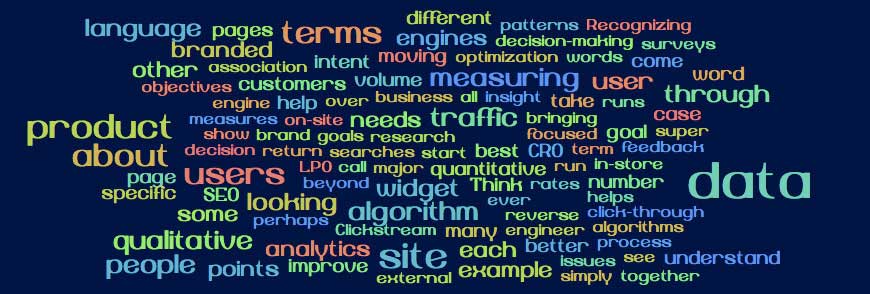Your google analytics account lets you measure page views, clickthrough rates, bounce rates and other quantitative numbers. This is click stream data. It’s all numbers. It tells you the “What.”
What if you want to find out the “Why?”
Usability studies provides a depth of qualitative information, a narrative that is unmatched by just numbers. It’s the best way to understand the user, friction points and the underlying motivations.
Other methods include surveys, polls, and feedback through support/chat channels.
Search data also falls under this category of getting into the “voice of the customer.” Search data arises from organic search results, search engine marketing (SEM) campaigns and internal site-search logs over repeated sessions. What are they saying? What language and terminology resonates with them?
Landing Page Optimization (LPO)
One of the best practices of SEM is that the AdWords copy must match the tone and promise of your landing page. The feedback loop of optimizing the keywords and copy to improve conversions is Landing Page Optimization (LPO). A conversion in this context might mean a signup, a subscription to a newsletter or a sales lead.
A landing page doesn’t necessarily have to be created with a tool such as Unbounce. It’s understood that not everyone enters your website through the homepage. If you look through the Landing Pages report on GA, you can find the top pages that implicitly act as landing pages.
You’d use the same kinds of feedback loops described above to optimize your non-SEM landing pages, but this time with search keywords instead.
Conversion Rate Optimization (CRO)
In our previous post on the buyer’s journey, I described the search queries used at each stage of the buying process. CRO is the process of improving the flow of prospects from one stage to another, eventually leading to a purchase.
A holistic framework
All kinds of optimization: search engine, landing pages and conversion rates must go hand in hand. It’s not enough to simply optimize your pages for search engines without understanding how “ready to buy” the searcher is when they arrive at your site. You need both quantitative as well as qualitative analytics.
A process to use both kinds of data:
- Analysis: use analytics to identify trends, issues and areas for further investigation
- Answer “what”: form hypothesis and answer your “what” questions
- Answer “why”: look at the quantitative data and answer your “why” questions
- Implement changes
- Evaulate KPIs: use analytics to evaluate success of changes and repeat process

